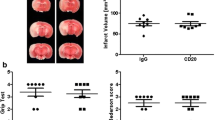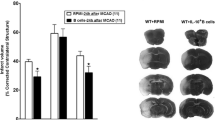Abstract
Recent evidence emphasizes B-cells as a major regulatory cell type that plays an important role in limiting the pathogenic effects of ischemic stroke. The aim of the current study was to extend this initial observation to specifically examine the infiltration of regulatory B-cells and to determine if the effect of B-cells to limit the inflammatory response to cerebral ischemia is mediated by their action centrally or peripherally. Our data demonstrate the increased presence of a regulatory B-cell subset in the affected hemisphere of wild-type mice after middle cerebral artery occlusion (MCAO). We further explored the use of a novel method of stereotaxic cell delivery to bypass the blood brain barrier (BBB) and introduce CD19+ B-cells directly into the striatum as compared to peripheral administration of B-cells. Infarct volumes after 60 minutes of MCAO and 48 hours of reperfusion were determined in B-cell deficient μMT−/− mice with and without replacement of either B-cells or medium. Infarct size was significantly decreased in cerebral cortex after intrastriatal transfer of 100,000 B-cells to μMT−/− mice vs. controls, with a comparable effect on infarct size as obtained by 50 million B-cells transferred intraperitoneally. These findings support the hypothesis that B-cells play a protective role against ischemic brain injury, and suggest that B-cells may serve as a novel therapeutic agent for modulating the immune response in central nervous system inflammation after stroke.





Similar content being viewed by others
References
Ajmo CT, Vernon DO, Collier L, Hall AA, Garbuzova-Davis S, Willing A, Pennypacker KR (2008) The spleen contributes to stroke-induced neurodegeneration. J Neurosci Res 86(10):2227–2234
Akiyoshi K, Ren X, Dziennis S, Vandenbark AA, Herson PS, Hurn PD, Offner H (2011) Regulatory B-cells limit CNS inflammation and neurologic deficits in murine experimental stroke. J Neurosci 31:8556–8563
Campanella M, Sciorati C, Tarozzo G, Beltramo M (2002) Flow cytometric analysis of inflammatory cells in ischemic rat brain. Stroke 22(2):586–592
Carter NA, Vasconcellos R, Rosser EC, Tulone C, Munoz-Suano A, Kamanaka M, Ehrenstein MR, Flavell RA, Mauri C (2011) Mice lacking endogenous IL-10-producing regulatory B cells develop exacerbated disease and present with an increased frequency of Th1/Th17 but a decrease in regulatory T cells. J Immunol 186:5569–5579
de Bilbao FDA, Moll T, Garcia-Gabay I, Vallet P, Langhans W, Giannakopoulos P (2009) In vivo over-expression of interleukin-10 increases resistance to focal brain ischemia in mice. J Neurochem 110:12–22
DiLillo DJ, Matsushita T, Tedder TF (2010) B10 cells and regulatory B cells balance immune responses during inflammation, autoimmunity, and cancer. Ann N Y Acad Sci 1183:38–57
Frenkel D, Huang Z, Maron R, Koldzic DN, Moskowitz MA, Weiner HL (2005) Neuroprotection by IL-10-producing MOG CD4+ T cells following ischemic stroke. J Neurol Sci 233:125–132
Gee JM, Kalil A, Shea C, Becker KJ (2007) Lymphocytes: potential mediators of postischemic injury and neuroprotection. Stroke 38:783–788
Grilli M, Barbieri I, Basudev H, Brusa R, Casati C, Lozza G, Ongini E (2000) Interleukin-10 modulates neuronal threshold of vulnerability to ischaemic damage. Eur J Neurosci 12:2265–2272
Hurn PD, Subramanian S, Parker SM, Afentoulis ME, Kaler LJ, Vandenbark AA, Offner H (2007) T- and B-cell-deficient mice with experimental stroke have reduced lesion size and inflammation. J Cerebral Blood Flow & Metab 27:1798–1805
Liesz A, Suri-Payer E, Veltkamp C, Doerr H, Sommer C, Rivest S, Giese T, Veltkamp R (2009) Regulatory T cells are key cerebroprotective immunomodulators in acute experimental stroke. Nature Medicine 15(2):192–199
Mann MK, Maresz K, Shriver LP, Tan Y, Dittel BN (2007) B cell regulation of CD4 + CD25+ T regulatory cells and IL-10 via B7 is essential for recovery from experimental autoimmune encephalomyelitis. J Immunol 178:3447–3456
Matsushita T, Horikawa M, Iwata Y, Tedder TF (2010) Regulatory B cells (B10 cells) and regulatory T cells have independent roles in controlling experimental autoimmune encephalomyelitis initiation and late-phase immunopathogenesis. J Immunol 185:2240–2252
Offner H, Hurn PD (2012) A novel hypothesis: regulatory B lymphocytes shape outcome from experimental stroke. Transl Stroke Res In press
Offner H, Subramanian S, Parker SM, Afentoulis ME, Vandenbark AA, Hurn PD (2006a) Experimental stroke induces massive, rapid activation of the peripheral immune system. J Cerebral Blood Flow & Metab 26:654–665
Offner H, Subramanian S, Parker SM, Wang C, Afentoulis ME, Lewis A, Vandenbark AA, Hurn PD (2006b) Splenic atrophy in experimental stroke is accompanied by increased regulatory T cells and circulating macrophages. J Immunol 176:6523–6531
Planas AM, Gorina R, Chamorro A (2006) Signalling pathways mediating inflammatory responses in brain ischaemia. Biochem Soc Trans 34:1267–1270
Yanaba K, Bouazis J-D, Haas KM, Poe JC, Fujimoto M, Tedder TF (2008) A regulatory B cell subset with a unique CD1dhiCD5+ phenotye controls T cell-dependent inflammatory responses. Immunity 28:639–650
Yilmaz G, Arumugam TV, Stokes KY, Granger DN (2006) Role of T lymphocytes and interferon-gamma in ischemic stroke. Circulation 113(17):2105–2112
Zhu W, Wang L, Zhang L, Palmateer JM, Libal NL, Hurn PD, Herson PS, Murphy SJ (2010) Isoflurane preconditioning neuroprotection in experimental focal stroke is androgen-dependent in male mice. Neuroscience 169(2):758–769
Acknowledgments
The authors wish to thank Drs. Xuefang Ren, Wenri Zhang and Kozaburo Akiyoshi for assistance in some experiments, Ms. Eva Niehaus for assistance with manuscript preparation and Ms. Zefora Alderman for graphics. This work was supported by NIH grant NS075887. This material is based upon work supported in part by the Department of Veterans Affairs, Veterans Health Administration, Office of Research and Development, Biomedical Laboratory Research and Development. The contents do not represent the views of the Department of Veterans Affairs or the United States Government.
Author information
Authors and Affiliations
Corresponding author
Additional information
Yingxin Chen and Sheetal Bodhankar contributed equally to this work
Rights and permissions
About this article
Cite this article
Chen, Y., Bodhankar, S., Murphy, S.J. et al. Intrastriatal B-cell administration limits infarct size after stroke in B-cell deficient mice. Metab Brain Dis 27, 487–493 (2012). https://doi.org/10.1007/s11011-012-9317-7
Received:
Accepted:
Published:
Issue Date:
DOI: https://doi.org/10.1007/s11011-012-9317-7




